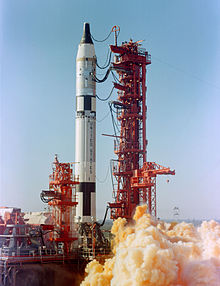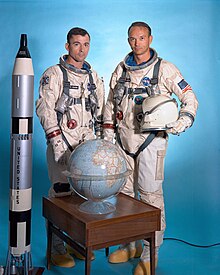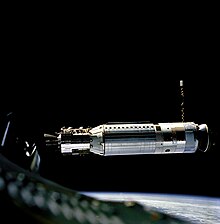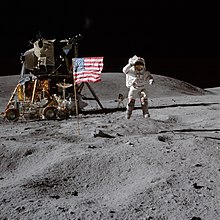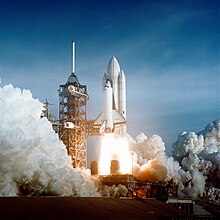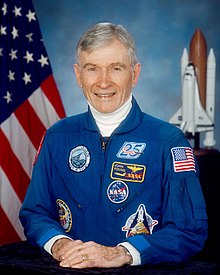John Watts Young
| John Young | |
|---|---|

|
|
| Country: | United States |
| Organization: | NASA |
| selected on | September 17, 1962 (2nd NASA Group) |
| Calls: | 6 space flights |
| Start of the first space flight: |
March 23, 1965 |
| Landing of the last space flight: |
December 8, 1983 |
| Time in space: | 34d 19h 39min |
| EVA inserts: | 3 |
| EVA total duration: | 20h 15min |
| retired on | December 31, 2004 |
| Space flights | |
John Watts Young (born September 24, 1930 in San Francisco , California - † January 5, 2018 in Houston , Texas ) was the American astronaut with the longest career to date at NASA . As the commander of Apollo 16, he was the ninth of twelve people on the moon to date and commanded the first flight of a space shuttle in 1981 . He is the only person who has piloted four different spacecraft: Gemini , Apollo Command Module , Apollo Lunar Module , and Space Shuttle . Over the course of his career, he has set many other records in the aerospace industry.
youth
John Young was born in the US state of California, the family later moved to Georgia and then to Florida . He spent most of his youth in Florida with his parents and younger brother. Even then he was interested in flying, built small aircraft models and read a lot about airplanes. His grandfather taught him to read and by the age of five he was already reading from the dictionary. His father was employed as a civil engineer during this time.
After finishing school, Young studied at the Georgia Institute of Technology in Atlanta and graduated with top honors in aeronautical engineering in 1952. He then joined the US Navy and served a year on the destroyer USS Laws during the Korean War .
After the Korean War, he was trained as a pilot and flew fighter planes for four years. In 1959, he began test pilot training at the United States Naval Test Pilot School . Until 1962 he was stationed at the Naval Air Test Center and evaluated the Phantom and Crusader weapon systems.
With the F-4 Phantom , John Young set two world records in climb flight. On February 21, 1962, it only took him 34.5 seconds to reach an altitude of 3000 meters. In doing so, he undercut the three-day-old record set by US Air Force pilot Walter F. Daniel by 1.1 seconds. Young's record lasted almost thirteen years and was not broken until January 16, 1975 by Roger J. Smith with an F-15A (27.57 s).
Just a few weeks after his record flight, he set another world record, this time climbing to 25,000 meters. On April 3, 1962, it took him three minutes and 50 seconds. He improved the old mark from 1958 by 36 seconds. This record also lasted for many years and was only broken in 1973 by Pyotr Ostapenko with the MiG-25 record version Mikoyan-Gurevich Je-266 .
At that time he felt inspired by the words of then US President John F. Kennedy from 1961 to send a person to the moon and safely back, and from then on he wanted to become an astronaut, which he finally succeeded.
In 1976, and after 25 years of service, Young retired from the Navy with the rank of Captain .
Gemini program
Gemini 3
Young was selected into the second astronaut group by NASA on September 17, 1962. The training for the Gemini program , in contrast to the Mercury training, had been significantly tightened. It was no longer pure passengers of the spaceships in demand. The Gemini spacecraft are controlled and had to be coupled to other spaceships were still spacewalks planned. In addition, the budding astronauts had to familiarize themselves with significantly more launch vehicles , as the follow-up project, the Apollo program , was already being planned. The individual workshops and assembly sites as well as the launch ramps for the Titan , Atlas , Agena and Saturn rockets were visited one after the other . Scientific training was also on the program, as research work also had to be carried out during space flights.
In January 1963 he was assigned as a specialty the equipment of the astronauts in the spaceships. This included both personal equipment and emergency equipment in the event of an emergency landing or ditching. Gordon Cooper was responsible for this area in the Mercury program .
On April 13, 1964, Young was nominated as a pilot for the first manned flight of the Gemini spacecraft, replacing Tom Stafford , who harmonized less well with the mission's commander, Virgil Grissom . Young was the first astronaut of the second group to come to a space mission.
Under the command of Mercury veteran Virgil Grissom, who was the first person to perform his second space flight on this mission, he completed the first US two-man flight and manned maiden flight of the Gemini spacecraft on March 23, 1965 with Gemini 3 .
In coordination with Young, Grissom chose the callsign Molly Brown for Gemini 3 after the Broadway musical The unsinkable Molly Brown . This was a reference to Grissom's first space flight, Mercury-Redstone 4 , in which the landing capsule had sunk into the sea. NASA was not particularly happy about the naming and had a dispute with Grissom about it, so it was the last mission before Apollo 9 in which the space travelers were allowed to name their ships.

At the beginning of the flight, problems arose with the internal atmosphere readings. It quickly turned out that it was a display error and that the air we breathed met the expectations placed in it.
Young operated the first computer in space at Gemini 3. The flight control was excited that Young had smuggled a corned beef sandwich on board, the crumbs of which were flying around in the spacecraft in weightlessness. The sandwich was a favorite of Commander Grissom, who had tried the space traveler's food on Earth and didn't like it. This form of food was to be tested for the first time by humans in space. Before the start, Grissom announced that he would only eat them if there was nothing else edible on board. Young heard this and then took the sandwich into space to please Grissom. While enjoying the sandwich, Grissom only complained jokingly that there was no mustard.
After three orbits the earth the brake rockets were fired. The landing on parachutes was carried out in two phases, in which the landing capsule hung on the parachute first with the nose up, then with the nose down at an angle. When moving from one position to the other, the two astronauts were thrown against the window. Young's helmet was scratched, and Grissom's visor even broke.
Gemini 3 had incorrectly estimated the air resistance of the landing capsule, and so it landed 84 km from the target point and it took 30 minutes until a rescue helicopter was on site. Grissom refused to open the hatches until divers had secured them with tapes, still afraid that the Molly Brown might sink like the Liberty Bell had before . The long rocking at sea made both astronauts seasick in the capsule.
Both astronauts got a confetti parade on the streets of New York in rainy weather in the presence of the US Vice President Hubert H. Humphrey . Up to this point, only astronauts Alan Shepard and John Glenn had received this honor.
This space mission was by far the shortest of his long astronaut career.
Since that time together, the two astronauts had a deep friendship, which was suddenly ended by the death of Grissom in 1967 during the preparations for Apollo 1 . Young attended Grissom's funeral as an honor guard.
Gemini 10
Shortly thereafter, Young and Grissom were nominated as substitutes for the Gemini 6 mission , which took place in December 1965.
On January 25, 1966, Young was announced as the commander of Gemini 10 , its pilot would be Mike Collins , who would later become the pilot of the Apollo spacecraft on the first Apollo 11 lunar landing mission . Young made his second space flight on July 18, 1966.
During this mission, both a coupling with an Agena satellite in space and, for the first time, two space exits were made by Collins. The coupling with the Agena had absolute priority for this mission, since difficulties arose with Gemini 8 and Gemini 9 could not come to the coupling at all. At the same time, a new world altitude record was set, the first encounter with two different objects was completed on a mission, and for the first time a spacecraft docked with another and used its propulsion system. Upon completion of the mission, Young was the second astronaut of the second astronaut group to have been in space a second time.
He later became a liaison spokesperson ( Capcom ) for Gemini 11 .
Apollo program
Apollo 10
After completing the Gemini program , Young joined the Apollo program .
On December 22, 1966, the crews for the first Apollo flights were announced. Young was initially a reserve pilot on the second manned mission. The plans were suspended after the Apollo 1 disaster , in which Young's former commander and friend Grissom and two other astronauts tragically lost their lives.
The new plans were published on May 9, 1967 and stipulated that Young would be the replacement pilot of Apollo 7 (Mission C) in Earth orbit, if the pilot Walter Cunningham had failed, Young would have become a maiden pilot again as in the Gemini program and the first human with three space flights. This flight took place in October 1968; Young was one of the liaison speakers and Walter Schirra was the first person to do 3 space flights .
Shortly thereafter, on November 13, 1968, Young was nominated as pilot of the Apollo spacecraft for the Apollo 10 mission , which was the dress rehearsal for the moon landing.
This flight took place from May 18 to May 26, 1969. Young was the first to remain alone in lunar orbit as a pilot in the mother ship Charlie Brown , while Commander Tom Stafford and pilot Eugene Cernan successfully simulated a moon landing in the Snoopy lunar module.
The re-entry into the earth's atmosphere took place at a speed of 11.08 km / s (39,897 km / h), which is still the record in manned space travel and the highest speed that humans have ever reached relative to the earth's surface.
The successful flight of Apollo 10 showed that NASA could complete Apollo flights in quick succession. In addition, Apollo 10 had performed all the maneuvers necessary for a moon landing, except for the landing itself. It was the first space mission in which a television film was made in color. With Young and Cernan, the last Apollo mission commanders had flown into space on this flight. With this flight, Young was the fourth person to do three space flights.
Shortly after the Apollo 11 moon landing in July 1969, Young was assigned as the replacement commander of Apollo 13 , but was not deployed and therefore took over a few shifts as a liaison officer ( Capcom ) in Houston . He assisted the original pilot of Apollo 13 and later pilots of his Apollo mission, Thomas K. Mattingly , who mastered important functions of the rescue operation of Apollo 13 on earth and at the same time he was also one of the liaison spokesmen for this mission.
Apollo 16
In March 1971, Young received his first Apollo command: with Apollo 16 , he was supposed to take over the penultimate moon landing that led the astronauts to the Descartes lunar crater . On board were the pilot of the Apollo spacecraft Thomas K. Mattingly and the pilot of the lunar module, Charles M. Duke . The flight took place from April 16 to April 27, 1972, Young was the ninth person to walk on the moon on April 20. On this mission, Young and Duke set a new EVA record of 7 hours and 23 minutes.
The moon car was used for the second time on this mission, and Young covered a total distance of 26 km in the moon car, the largest distance traveled on the moon at the time. Young also holds the record for fastest motorist on the moon at 12 km / h. In addition, Young and Duke took the second most abundant lunar rock load of an Apollo mission to earth with 95.8 kg. A sample of this rock can be viewed in the Nördlinger Rieskrater Museum . For the first time in the history of lunar missions, a plateau of the moon was examined.
The 71 hours and 2 minutes that Young and Duke were on the moon is the second longest time humans have been on the moon.
On re-entry , the astronauts had to endure a pressure of 7.19 g, the highest value that has been measured for an Apollo mission.
With this Apollo mission, Young became the second human with four space flights tied with Jim Lovell , although Young had also made a start from the moon, but Lovell did not, because he had not landed on the moon with Apollo 13, as was originally planned . It was also the longest of his six space missions.
In the run-up to the last flight to the moon, Apollo 17 , the main and substitute crews were redeployed. After their successful flight with Apollo 16, Young and Duke were reassigned as replacements for the next flight, as it would not have made sense to train a completely new replacement team, which had no chance to fly a regular Apollo mission later can. If the Apollo 17 commander, Young's Apollo 10 teammate, Eugene Cernan, had failed, Young would have been the only person to make a third moon flight and a second moon landing and would have been the first person to complete five space flights. Since this was not the case, Young again served as one of the liaison spokesmen for the last Apollo Moon mission.
Space Shuttle Program
STS-1
After completing the Apollo program, Young became head of the space shuttle division of the astronauts office in January 1973 and made sure that the astronauts had sufficient influence on the development of the new space shuttle . The information that Congress had approved the funds for the space shuttle program had, curiously, reached Young while he was on the moon with Apollo 16. In January 1974 he succeeded Alan Shepard as head of the astronauts office and was responsible for coordinating all astronaut activities. In 1976 Young officially resigned from the US Navy.
When the space shuttle was completed, Young received the honor of commanding the maiden flight as he had the most experience in space of any of NASA's active astronauts; it was the US's first manned space flight after the Apollo-Soyuz project in almost six years. From April 12 to 14, 1981, he and his pilot Bob Crippen tested all systems of the Space Shuttle Columbia during the STS-1 mission in Earth orbit . The payload was a flight monitoring system, consisting of sensors and measuring instruments to record data on all critical flight segments. It was the first time NASA deployed a new spacecraft without first performing unmanned test flights, as the space shuttle wasn't able to fly and land remotely at the time, and the first time a manned spacecraft did not go down on parachutes , but landed gliding . It was also the first time that astronauts were brought into space with the help of a solid fuel propulsion system.
Young was the first space traveler to undertake five flights into space, and is still one of only two people, along with Vladimir Komarov , who were allowed to make two maiden flights . He is also the only astronaut in NASA's 2nd selection group to have flown the space shuttle. NASA describes the STS-1 as "the boldest test flight in history". Young himself later stated in an interview that he did not know whether the mission was dangerous and that no data had been available to prove or disprove the existence of an increased risk.
STS-9
Young had his sixth and last space mission as commander of the STS-9 mission from November 28 to December 8, 1983, during which the ESA's Spacelab space laboratory was carried for the first time . On board were the pilot Brewster Shaw , the mission specialists Robert Parker and Owen Garriott , and the payload specialists Byron Lichtenberg and Ulf Merbold . It was the first space flight with six space travelers. At the same time, this was the first NASA mission in which a non-American, the German science astronaut Ulf Merbold, was a member of the crew and undertook his first space flight. This flight made Merbold the first West German in space. Merbold had been assigned to Young's red team on the flight with Bob Parker. Both teams worked twelve-hour shifts.
From a scientific point of view, the flight was a complete success, because by carrying the Spacelab more experiments could be carried out successfully than in all the Apollo and Skylab missions combined. Young was one of NASA's first astronauts to do STS-9 exercises on the treadmill in order not to let his muscles degenerate too quickly in space. At the same time, he was the one on the red team who prepared the food for the scientists. For the first time in his space career, Young flew over the great mountains of Central Asia and was fascinated by their beauty.
With this mission, Young became the first person to complete six space flights. That record lasted nearly thirteen years and wasn't set by Story Musgrave until 1996 ; But it was only outbid almost 19 years later by Jerry Ross in 2002, who was the first person to complete his seventh space flight. Young is a personal role model for Ross.
STS-61-J
Young was nominated for another flight as commander, it was to be the mission STS-61-J , during which the prestigious Hubble space telescope was to be launched from August 18 to 23, 1986 , as a spacecraft the shuttle Atlantis was planned, which with it would have made his third space flight. This flight was canceled after the Challenger disaster and later carried out under a different mission code ( STS-31 ) with almost the same crew, although Young was replaced as commander by Loren Shriver .
Worked for NASA after his space flights
Young was replaced in May 1987 as head of the astronauts office by Daniel Brandenstein and appointed special assistant to the director of the Johnson Space Center in Houston ; In Young's own assessment, the replacement was a reaction to his high-profile criticism of NASA's safety culture that led to the Challenger disaster. In this role he worked in the engineering sector and specialized in the improvement of the space shuttle fleet and the operational safety of the future International Space Station ISS . Safety was particularly important to him, as he had lost his friend and Gemini 3 teammate, Gus Grissom, because the safety of the astronauts at Apollo 1 had been saved.
In addition, he was responsible for future and extended planning of manned space travel (e.g. manned lunar and Mars missions), which are to be carried out with the Orion spaceship (previously as a Crew Exploration Vehicle , CEV) from 2014.
In February 1996, he took over the post of technical director of the Johnson Space Center. In this function he again monitored the safety aspects as well as the technical and operational progress of NASA missions.
After 42 years in the service of NASA, Young retired on December 31, 2004 at his own request at the age of 74 as NASA's longest-serving astronaut. He was personally honored in a ceremony on December 7, 2004 at the National Air and Space Museum . Young was the only astronaut of the first two astronaut groups who did not leave NASA prematurely to go into politics or business, and worked there until his very late retirement, if you can tell from the prematurely deceased Elliot See , Gus Grissom and Ed White disregards, who died accidentally in the service of NASA.
On the 40th anniversary of the Apollo 1 catastrophe on January 27, 2007, Young gave an official speech in Cape Canaveral on the LC34 .
Summary of space flights
| No. | mission | function | Flight date | Flight duration |
|---|---|---|---|---|
| 1 | Gemini 3 | pilot | March 23 - March 23, 1965 | 0 d 4 h 52 min |
| 2 | Gemini 10 | commander | July 18 - July 21, 1966 | 2 d 22 h 46 min |
| 3 | Apollo 10 | pilot | May 18 - May 26, 1969 | 8 d 0 h 03 min |
| 4th | Apollo 16 | commander | April 16 - April 27, 1972 | 11 d 1 h 51 min |
| 5 | STS-1 | commander | April 12 - April 14, 1981 | 2 d 06 h 20 min |
| 6th | STS-9 | commander | November 28 - December 8, 1983 | 10 d 07 h 47 min |
Résumé
Young was one of the most famous space travelers worldwide and was to be found in prominent positions in modern space travel, as he not only worked as an astronaut in space, but also played a pioneering role in the development of modern space technology in NASA, even though he was a Was a veteran of the Gemini Program and Apollo Program. John Young had a total of more than 15,275 flight hours with airplanes, helicopters, lunar shuttles, spaceships and rockets on his account, 9200 alone with the Northrop T-38 , he also spent over 15,000 hours in various simulators, making him one of the most experienced pilots and astronauts our time. This includes his 835 hours of space flight.
Special features and records
Young has set many first achievements and records on his aircraft test and space flights:
Test flyer
- World record holder in ascent at 3000 meters from 1962 to 1974 and at 25,000 meters from 1962 to 1973
Gemini
- first American two-man flight, with Gus Grissom ( Gemini 3 )
- first use of a computer in space ( Gemini 3 )
- World altitude record at that time with 763 km ( Gemini 10 )
- first coupling in space using the drive of the other object ( Gemini 10 )
- first coupling in space with an object and rendezvous with another object on a mission ( Gemini 10 )
Apollo
- first person alone in lunar orbit ( Apollo 10 )
- first rendezvous in lunar orbit ( Apollo 10 )
- highest speed (relative to earth) that humans have ever reached (39,897 km / h with Apollo 10 )
- first person who was twice in lunar orbit ( Apollo 10 and Apollo 16 ) (although not the first to fly to the moon twice, that was Jim Lovell )
- longest EVA deployment at that time with 7 hours and 23 minutes ( Apollo 16 )
- longest time on the moon at that time with 71 hours and 2 minutes ( Apollo 16 )
- heaviest load when re-entering an Apollo landing capsule with 7.19 g ( Apollo 16 )
Space shuttle
- first space shuttle flight ( STS-1 )
- first human to land a spaceship like an airplane ( STS-1 )
- first six-man flight ( STS-9 )
- first person with five ( STS-1 ) and with six space flights ( STS-9 ), seven if you include his start from the moon
Others
- first and so far only person who has piloted four different spacecraft ( Gemini spacecraft , Apollo spacecraft , Apollo lunar module and space shuttle )
- first and so far only NASA astronaut who completed two maiden flights ( Gemini 3 , STS-1 )
- first and so far only person who has flown twice in three programs ( Gemini , Apollo , Space Shuttle )
- first person to command a mission four times ( Gemini 10 , Apollo 16 , STS-1 and STS-9 )
- when he retired at the age of 42 with NASA, he was the longest-serving astronaut
The fact that Young was the first astronaut of the second selection group to be used and the first person to complete six space flights, and almost the first person to undertake the seventh space flight, clearly shows the importance Young has for manned US space travel. This can also be seen in the fact that he became head of the astronauts office and later technical director of the Johnson Space Center , which has the longest career in space to date (as an actively listed astronaut) worldwide and was an active astronaut until his retirement. If mission STS-61-J had taken place, he would have had the longest space career from first flight to last flight on his account.
Private life
Young was married twice. He was the first astronaut to divorce his first wife Barbara on active duty. The most important event for Young personally was the wedding with his second wife Susy.
From his first marriage to Barbara he had two children: John and Sandy, he also had two grandchildren named Kaithy and Lindsey.
He was an interested handball player, wind surfer, cyclist; Jogging was also one of his hobbies. He also enjoyed reading, mostly history and research literature, and gardening. He played the guitar , ukulele and harmonica privately and enjoyed smoking a pipe or cigar. Young was a member of the largest American fraternity, Sigma Chi, and was known for his humor and dry wit.
Last Young lived in Houston ( Texas ).
Honors
On May 19, 1981, John Young was the seventh astronaut to receive the Congressional Space Medal of Honor personally from US President Ronald Reagan . It is the highest award for American astronauts. He is the only astronaut who received this medal directly after the space flight to be honored, less than a month apart. All other 27 winners of this award did not receive it until at least a year after the event. He is also the first astronaut to receive this award after being awarded six times in 1978. He has also received over eighty other awards and six honorary doctorates.
- He has been a member of the National Aviation Hall of Fame since 1988 , which very few astronauts are members of.
- He is a member of the Astronaut Hall of Fame .
- He became an honorary member of the Explorers Club in 1981.
- The John Young Parkway in Orlando ( Florida ) is named after him.
- After Gemini 3, Paraguay and Yemen issued a postage stamp with the two astronauts.
- After Apollo 10, Yemen again issued a stamp with the crew.
Trivia
When asked in 1996 if he would write an autobiography, his answer was that he was too young for that: “No, I'm too young for that!” His autobiography was published on September 10, 2013 under the title Forever Young .
See also
- List of spacemen
- Country statistics of manned spaceflight
- Records of manned spaceflight
- List of space shuttle missions
- List of manned space flights
- List of space exits
literature
- Ulf Merbold: Flight into space. From Spacelab 1 to the D1 mission. The personal report of the first astronaut in the Federal Republic. Lübbe, Bergisch Gladbach 1986, ISBN 3-404-60252-8 .
- Life magazine . April 2, 1965.
- National Aeronautics and Space Administration: The most experienced man in space Leaflet dated December 7, 2004.
Web links
- Short biography of John Watts Young at spacefacts.de
- NASA biography of John Watts Young (PDF)
- Biography of John Watts Young in the Encyclopedia Astronautica (English)
- NASA TV: NASA astronaut John Young on Youtube (10:37 minutes, English)
- STS-1 Space Shuttle Columbia on Youtube (4:10 minutes, English)
- NASA: retirement with a tribute by Tom Hanks (English)
- Astonews.com: Picture of the Day January 8, 2018
swell
- ↑ NASA: Legendary astronaut, moonwalker John Young has died
- ↑ John Young, ninth astronaut on moon, led first shuttle mission, dies
- ↑ a b c d e f g h i j k l NASA biography of John Watts Young , accessed on October 14, 2009 (PDF).
- ↑ FAI Record ID # 9078. In: fai.org. Retrieved on August 23, 2017 .
- ↑ FAI Record ID # 9077. In: fai.org. Retrieved on August 23, 2017 .
- ↑ FAI Record ID # 9092. In: fai.org. Retrieved on August 23, 2017 .
- ↑ FAI Record ID # 9080. In: fai.org. Retrieved on August 23, 2017 .
- ↑ Fai Record ID # 9071. In: fai.org. Retrieved on August 23, 2017 .
- ^ A b John W. Young with James R. Hansen: Forever Young: A Life of Adventure in Air and Space. 2013, accessed February 5, 2016 .
- ↑ Biography. 2007, accessed October 14, 2009 .
| personal data | |
|---|---|
| SURNAME | Young, John Watts |
| BRIEF DESCRIPTION | American astronaut |
| DATE OF BIRTH | September 24, 1930 |
| PLACE OF BIRTH | San Francisco , California, USA |
| DATE OF DEATH | 5th January 2018 |
| Place of death | Houston , Texas, USA |


